As an avid gardener, I’m always on the lookout for unique and eye-catching plants to add a pop of color to my garden. One day, as I was strolling through a local nursery, my attention was immediately drawn to a stunning display of plants with vibrant yellow and green foliage. The contrasting colors created a mesmerizing effect, instantly brightening up the entire space.
I couldn’t resist the urge to bring some of these yellow and green leaf plants home with me. Their striking appearance not only added beauty to my garden but also sparked a sense of curiosity. I wanted to learn more about these plants, their characteristics, and how to care for them properly.
Little did I know that my journey into the world of plants with yellow and green leaves would uncover a wealth of information about the importance of leaf color and the various factors that can contribute to the appearance of yellow leaves. From nutritional deficiencies to diseases and pests, the yellowing of leaves can be a sign of underlying problems that require attention and care.
Join me as we delve into the fascinating world of plants with yellow and green foliage. Together, we’ll explore the reasons behind yellow leaves, how to identify the root causes, and practical tips to prevent and treat the yellowing of leaves. Whether you’re an experienced gardener or just starting out, this guide will equip you with the knowledge and tools to maintain vibrant and healthy plants.
Key Takeaways:
- Plants with yellow and green leaves can add a vibrant touch to any garden or indoor space.
- Yellow leaves can be a sign of various problems, including nutritional deficiencies, diseases, water stress, or pests.
- Identifying the root cause of yellow leaves is crucial for taking appropriate action to address the issue and prevent further damage.
- Proper watering, providing adequate nutrients, maintaining a pest-free environment, and ensuring suitable growing conditions can help prevent the appearance of yellow leaves on plants.
- There are several home remedies that can be used to treat yellow leaves on plants, including using white vinegar diluted in water, making compost tea, preparing garlic solution, or using herbal teas such as chamomile or nettle.
The Yellow Leaf: Why Does It Happen and What Does It Mean?
A yellow leaf on plants can be a cause for concern, indicating a problem with the plant’s health. When the vibrant green leaves turn yellow, it signifies a change in color and condition. Understanding the causes and meaning behind yellow leaves is essential for addressing the issue effectively.
Yellow leaves on plants can be caused by a variety of factors, including:
- Nutritional deficiencies
- Diseases
- Water stress
- Pests
Let’s delve deeper into each of these causes:
- Nutritional deficiencies: When plants lack essential nutrients such as nitrogen, iron, magnesium, or potassium, their leaves may turn yellow. These nutrients are crucial for various plant functions, and their deficiency can disrupt the natural green color of the foliage.
- Diseases: Certain plant diseases can lead to the yellowing of leaves. Fungal, bacterial, or viral infections can affect the plant’s ability to perform photosynthesis, resulting in yellow foliage.
- Water stress: Overwatering or underwatering plants can lead to stress, causing the leaves to turn yellow. Insufficient water deprives the plant of essential moisture, while excessive watering can lead to root rot and inadequate oxygen supply.
- Pests: Insect infestations, such as aphids, spider mites, or whiteflies, can damage plant cells and tissues, leading to yellowing of leaves. These pests extract sap or cause wounds, interfering with the plant’s normal physiological processes.
Identifying the specific cause of yellow leaves is crucial for implementing the appropriate remedies. By closely examining the plant, conducting soil tests, and observing any visible symptoms, you can pinpoint the root cause of the problem and take the necessary steps to address it effectively.
Note: The image above depicts a yellow leaf, providing visual representation of the topic.
Identifying the Root Cause of the Problem
When yellow leaves appear on plants, it is essential to identify the underlying cause to address the issue effectively. By closely examining the plant and its environment, we can pinpoint the root cause of the yellowing leaves. Several factors may contribute to this problem:
- Under- or Overwatering: Improper watering practices can lead to yellow leaves. Insufficient watering can cause dehydration and nutrient deficiencies, while overwatering can result in waterlogged soil, depriving the roots of oxygen.
- Nutritional Deficiencies: Plants require a balanced supply of essential nutrients to thrive. Deficiencies in minerals such as nitrogen, iron, or magnesium can manifest as yellowing leaves.
- Diseases: Fungal, bacterial, or viral infections can affect the health of plants, leading to yellow leaves. Common diseases include powdery mildew, leaf spot, or root rot.
- Pests: Insect infestations, such as aphids, mites, or scale insects, can cause damage to the leaves, resulting in yellowing and wilting.
By observing the plant’s symptoms, examining the soil, and checking for signs of pests or diseases, we can determine the root cause of yellow leaves. This knowledge will guide our efforts to address the problem effectively and restore the plant’s health.
Quote
“Understanding the underlying cause of yellow leaves is like solving a mystery. By carefully investigating the plant and considering all possible factors, we can unravel the clues and find the solution that will bring back the vibrant green color to the foliage.”
Comparing Symptoms of Common Causes of Yellow Leaves
| Cause | Symptoms |
|---|---|
| Under- or Overwatering | Wilting, yellowing starting from the edges of the leaves, root rot in overwatered plants |
| Nutritional Deficiencies | Uniform yellowing, discoloration of specific parts of the plant, stunted growth |
| Diseases | Spots or patches on leaves, darkening or browning of affected areas, distorted growth |
| Pests | Visible insects, webbing, sticky residue on leaves, holes or chewed areas |

By carefully considering these factors and using the information gathered from observing the plant, we can effectively identify the root cause of yellow leaves. This knowledge empowers us to take the necessary steps to address the specific issue and restore the plant’s health and vitality.
How to Prevent the Appearance of Yellow Leaves on Plants
Preventing yellow leaves on plants is essential for maintaining their overall health and vitality. By following these tips and guidelines, you can avoid the unsightly yellowing of leaves and ensure that your plants thrive.
Proper Watering
One of the main causes of yellow leaves is improper watering. Overwatering or underwatering can stress the plants and lead to leaf discoloration. To prevent this, it’s important to:
- Water plants based on their specific needs. Different plants have varying water requirements, so research their watering needs to avoid over or under hydration.
- Use well-draining soil to prevent waterlogged roots and promote healthy growth.
- Allow the top layer of soil to dry out between watering to prevent overhydration.
Providing Adequate Nutrients
Nutritional deficiencies can also contribute to yellow leaves. To ensure your plants receive the necessary nutrients, consider the following:
- Fertilize plants regularly using a balanced fertilizer that suits their specific needs. This will provide the essential nutrients required for healthy leaf development.
- Monitor the pH levels of the soil, as extreme acidity or alkalinity can hinder nutrient absorption. Adjust the soil pH if necessary.
- Supplement the soil with organic matter or compost, which can improve nutrient retention and soil fertility.
Maintaining a Pest-Free Environment
Pests can cause stress to plants and lead to yellowing leaves. To prevent pest infestations:
- Inspect plants regularly for signs of pests, such as aphids, mites, or scale insects. Take immediate action if any pests are detected.
- Encourage natural predators like ladybugs or lacewings to control pest populations.
- Keep the surrounding area clean and free of debris that may attract pests.
Ensuring Suitable Growing Conditions
Creating an environment that meets the specific needs of your plants is crucial for preventing yellow leaves. Consider the following:
Proper placement: Position plants in an area that provides the right amount of sunlight, shade, and temperature. Different plants have varying light and temperature requirements, so research their specific needs.
Avoid extreme temperature fluctuations, as this can stress plants and lead to leaf discoloration. Keep plants away from drafts or sudden temperature changes.
Protect plants from harsh weather conditions, such as strong winds or frost, which can damage leaves.
By implementing these preventive measures in your plant care routine, you can minimize the risk of yellowing leaves and promote the overall health and beauty of your plants.
Note: The image above illustrates how proper care can help prevent yellow leaves on plants.
Home Remedies to Treat Yellow Leaves on Plants
If you notice yellow leaves on your plants, don’t fret! There are several effective home remedies that can help treat this issue and restore your plants’ health. These remedies are natural, easy to prepare, and can address the underlying problems causing yellowing leaves. Here are a few remedies you can try:
1. White Vinegar Solution
White vinegar is an excellent remedy for treating yellow leaves caused by nutritional deficiencies. Mix one tablespoon of white vinegar with one gallon of water and use it to water your plants. The vinegar helps to increase soil acidity, making nutrients more accessible to the plant roots.
2. Compost Tea
Compost tea is a nutrient-rich fertilizer that can help improve the overall health of your plants and prevent yellowing leaves. To make compost tea, simply soak compost in water for a few days. Then, strain the liquid and use it to water your plants. The nutrients in the compost tea will nourish the plants and promote healthy foliage.
3. Garlic Solution
Garlic has natural antifungal and antibacterial properties, making it an effective remedy for treating yellow leaves caused by diseases. Crush a few garlic cloves and mix them with water. Allow the mixture to sit overnight, then strain it and use it to spray your plants. The garlic solution will help inhibit the growth of pathogens and promote healthy, green leaves.
4. Herbal Teas
Herbal teas such as chamomile or nettle can also be used to treat yellow leaves on plants. These teas contain beneficial compounds that can improve plant health and aid in the recovery of yellowing foliage. Brew the tea according to the instructions on the packaging, allow it to cool, and use it to water your plants.
By using these home remedies, you can provide your plants with the necessary nutrients, protection against diseases, and a healthy growing environment. Remember to closely monitor your plants’ progress and adjust the remedies or seek professional advice if needed.
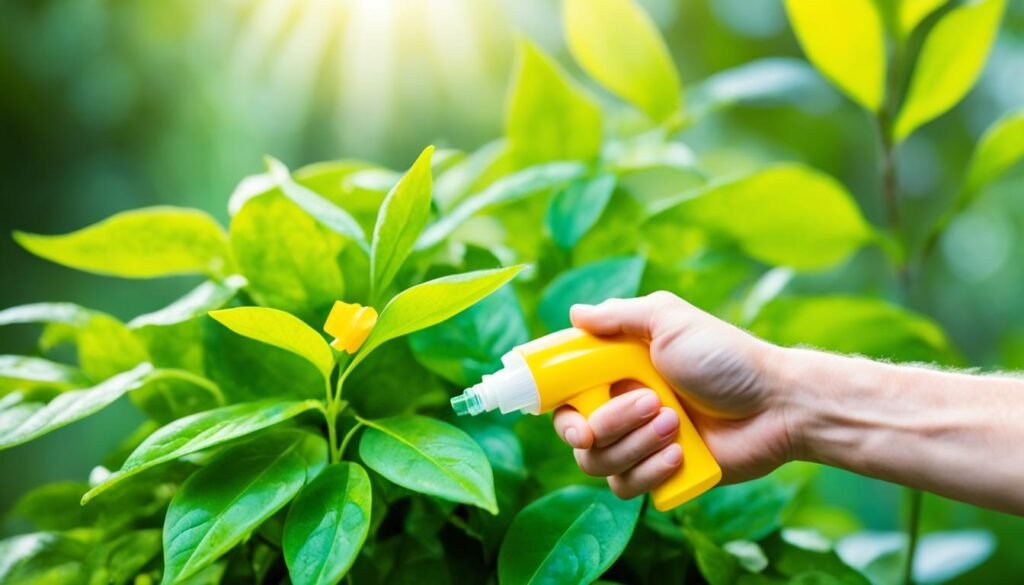
| Home Remedies | Benefits |
|---|---|
| White Vinegar Solution | Increases soil acidity, enhancing nutrient absorption |
| Compost Tea | Provides nutrient-rich fertilizer for plant health |
| Garlic Solution | Antifungal and antibacterial properties to combat diseases |
| Herbal Teas (Chamomile or Nettle) | Contains compounds that promote plant health and recovery |
Tips for Watering and Proper Plant Care
Proper watering is crucial for the health and well-being of your plants. By understanding the specific watering needs of each plant, you can ensure optimal growth and prevent issues such as yellow leaves. Here are some essential plant care tips to help you master the art of watering:
1. Research Water Requirements
Every plant has its unique water requirements. Some plants prefer moist soil, while others thrive in drier conditions. Research the specific needs of each plant in your collection to avoid over or under watering.
2. Quality Water Matters
“Water quality can significantly impact plant health. Ensure that the water you use is clean, free from chemicals, and suitable for plant consumption.”
3. Drainage is Key
Proper drainage is essential to prevent waterlogged soil, which can suffocate plant roots and lead to root rot. Choose pots or containers with drainage holes, and use well-draining soil to promote healthy root growth.
4. Soil and Compost Quality
“The quality of the soil and compost you use directly affects the water-holding capacity and nutrient availability for your plants.”
5. Observe and Assess
Regularly observe your plants for signs of underwatering or overwatering. Wilting, dry soil, and stunted growth may indicate a need for more water, while yellowing leaves and soggy soil may point to excessive watering.
6. Time it Right
Watering plants in the morning is generally ideal as it allows the foliage to dry off during the day, reducing the risk of fungal diseases. Avoid watering in the evening or late afternoon to prevent prolonged moisture on the leaves.
7. Consistency is Key
Establish a regular watering schedule to provide consistent moisture to your plants. Avoid sporadic or irregular watering, as it can stress the plants and lead to various issues, including yellow leaves.
To summarize, proper watering techniques and plant care are vital for maintaining healthy, vibrant plants. By researching water requirements, using quality water, ensuring proper drainage, and assessing your plants’ needs, you can create an optimal watering routine. Consistency and observation play crucial roles in preventing yellow leaves and promoting overall plant health.

| Watering Tips | Benefits |
|---|---|
| Research water requirements | Prevents over or under watering |
| Use quality water | Enhances plant health |
| Ensure proper drainage | Prevents root rot |
| Use quality soil and compost | Improves water retention and nutrient availability |
| Observe and assess | Identifies watering needs |
| Water in the morning | Reduces risk of fungal diseases |
| Maintain consistency | Establishes a watering routine |
How to Strengthen the Immune System of Plants to Avoid Disease
Strengthening the immune system of plants is crucial for promoting their health and preventing diseases. Just like humans, plants have mechanisms to defend themselves against pathogens and pests. By implementing certain practices, you can help boost the plants’ natural defenses and reduce the risk of diseases that can lead to yellow leaves and other issues.
To strengthen the immune system of your plants, consider the following:
- Provide adequate sunlight: Sunlight is essential for plants to carry out photosynthesis and produce energy. It also plays a crucial role in activating their defense mechanisms. Ensure that your plants are receiving the right amount of sunlight based on their specific requirements.
- Ensure proper ventilation: Good airflow around plants is important as it helps prevent the build-up of humid and stagnant conditions that can favor the growth of disease-causing organisms. Avoid overcrowding your plants and provide enough space for air circulation.
- Supply proper nutrition: Plants need a balanced diet of macro and micronutrients to stay healthy and resilient. Make sure to provide adequate fertilization and soil amendments to meet their nutritional needs. A well-nourished plant is better equipped to fight off infections.
- Practice proper watering: Overwatering or underwatering can weaken a plant’s immune system and make it more susceptible to diseases. Find the right balance and water your plants according to their specific needs. Avoid wetting the foliage excessively, as it can create a favorable environment for pathogens.
By implementing these practices, you can help strengthen your plants’ immune system, promoting their overall health and reducing the risk of diseases and yellow leaves caused by infections. Remember to observe your plants closely for any signs of stress or disease and take prompt action to address any issues that arise.
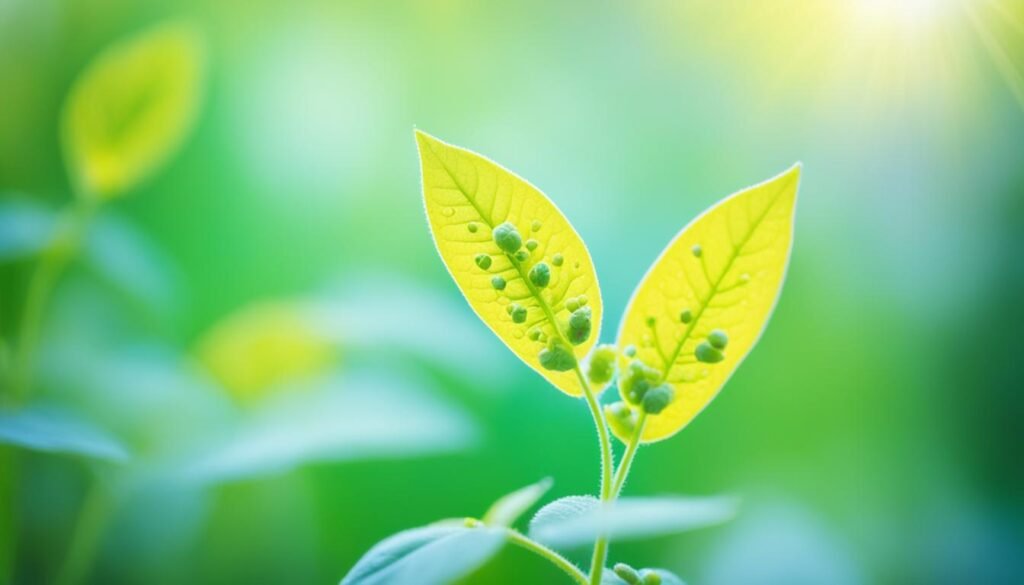
“Strengthening the immune system of plants plays a vital role in preventing diseases and maintaining plant health.” – [insert your full name]
Plants with Yellow and Green Foliage for Winter Interest
Winter landscapes often lack the vibrant colors associated with warmer seasons, but with plants boasting yellow and green foliage, you can bring a touch of brightness to your garden even during the coldest months. These evergreen plants not only provide structure and visual interest but also offer a pop of color that can elevate the overall aesthetics of your outdoor space.
Yellow foliage is especially captivating as it adds warmth and radiance to a winter garden. The golden hues can brighten up a gloomy day and create an inviting atmosphere. Whether you prefer shrubs, conifers, or other types of evergreens, there is a variety of plants with yellow and green foliage to choose from.
Let me highlight a few options:
1. Gold Dust Plant (Aucuba japonica ‘Variegata’)
The Gold Dust Plant is a popular choice for winter interest due to its shiny, green leaves generously flecked with yellow spots, resembling gold dust. This evergreen shrub thrives in partial to full shade and is an excellent option for adding texture and color to wooded areas of your garden.
2. Heavenly Bamboo (Nandina domestica)
Heavenly Bamboo, despite its name, is not a bamboo but rather a compact, evergreen shrub that features magnificent yellow and green foliage. Its vibrant colors intensify during winter, making it a standout addition to any garden. Additionally, Heavenly Bamboo produces clusters of bright red berries that further enhance its visual appeal.
3. Japanese Spurge (Pachysandra terminalis)
If you are looking for a low-maintenance ground cover with yellow and green foliage, Japanese Spurge is an excellent choice. This evergreen perennial forms a dense mat of glossy leaves that retain their variegation throughout the year. Japanese Spurge thrives in shaded areas, making it perfect for underplanting trees and shrubs.
These are just a few examples of plants with yellow and green foliage that can provide winter interest in your garden. Remember to consider factors such as sunlight exposure, soil conditions, and USDA hardiness zones when selecting plants for your specific location.
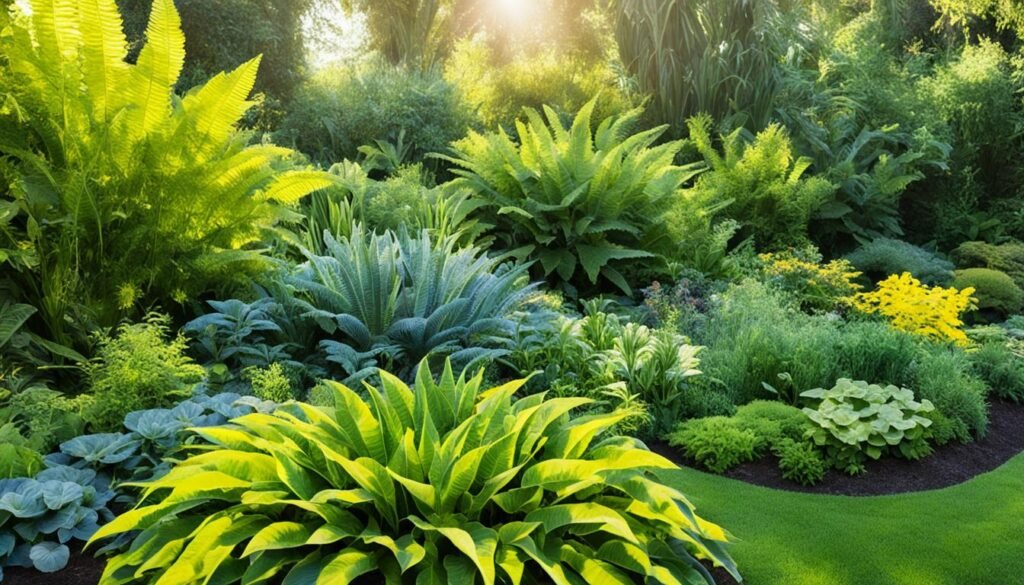
Not only do these plants add color to your winter garden, but they also contribute to the overall health and beauty of your outdoor space. By incorporating plants with yellow and green foliage into your landscape, you can create a visually appealing and inviting environment even during the coldest months.
Tips for Using Evergreen Plants with Yellow Foliage in Your Garden
When incorporating evergreen plants with yellow foliage into your garden, it’s important to consider their sun tolerance. Some varieties may be sensitive to direct sunlight and can easily burn, while others may lose their golden color when exposed to excessive shade. By understanding the sun requirements of these plants, you can ensure they thrive and maintain their vibrant yellow hues.
Combining yellow foliage with complementary colors can create visually stunning scenes in your garden. The contrasting colors can add depth and interest to your outdoor space. Consider pairing yellow foliage with shades of purple or blue for a striking combination, or mix it with warm tones like red or orange for a vibrant and energetic display.
Proper care and maintenance are essential for keeping yellow foliage plants healthy and vibrant. Here are some important tips:
- Ensure the plants are planted in well-draining soil that is rich in organic matter.
- Water the plants regularly, keeping the soil evenly moist but not waterlogged.
- Apply a layer of organic mulch around the base of the plants to help retain moisture and prevent weed growth.
- Regularly monitor the plants for any signs of pests or diseases, and take appropriate action if necessary.
- Trim and prune the plants as needed to maintain their shape and promote healthy growth.
To add an extra touch of visual appeal, you can position yellow foliage plants as focal points in your garden, such as near entrances or on either side of a pathway. This draws attention to their vibrant color and creates a memorable impression.
To reinforce the visual impact of evergreen plants with yellow foliage, it’s important to avoid overusing them. Incorporating too many can diminish their unique presence and make the garden appear overwhelming or chaotic. Instead, use them strategically to create focal points or as accents alongside other plants with different colors and foliage textures.
Remember, proper care and thoughtful placement will ensure that yellow foliage plants remain a delightful feature in your garden, bringing beauty and cheer throughout the seasons.
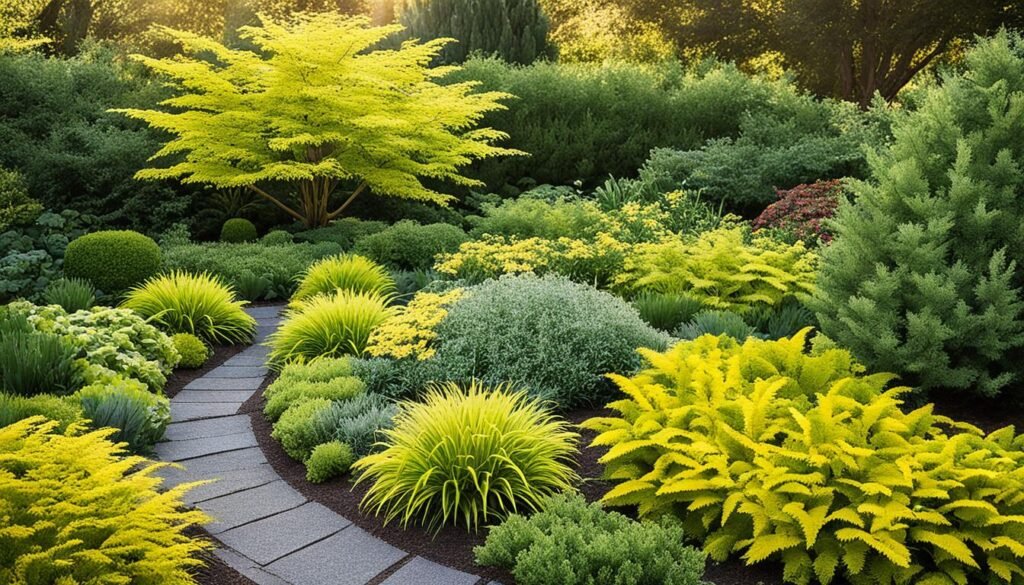
Yellow Foliage: A Ray of Sunshine in the Garden
Yellow foliage plants bring a bright and cheerful element to any garden. Whether they are vibrant shrubs, stunning conifers, or other varieties, these plants have the power to add radiance and warmth to outdoor spaces. The beautiful yellow hues create a captivating visual display that can brighten up any landscape.
When strategically placed and paired with other colors, yellow foliage plants can create stunning and eye-catching displays in the garden. The contrast between the yellow leaves and other plant species or colorful flowers can create a visually appealing and dynamic landscape.
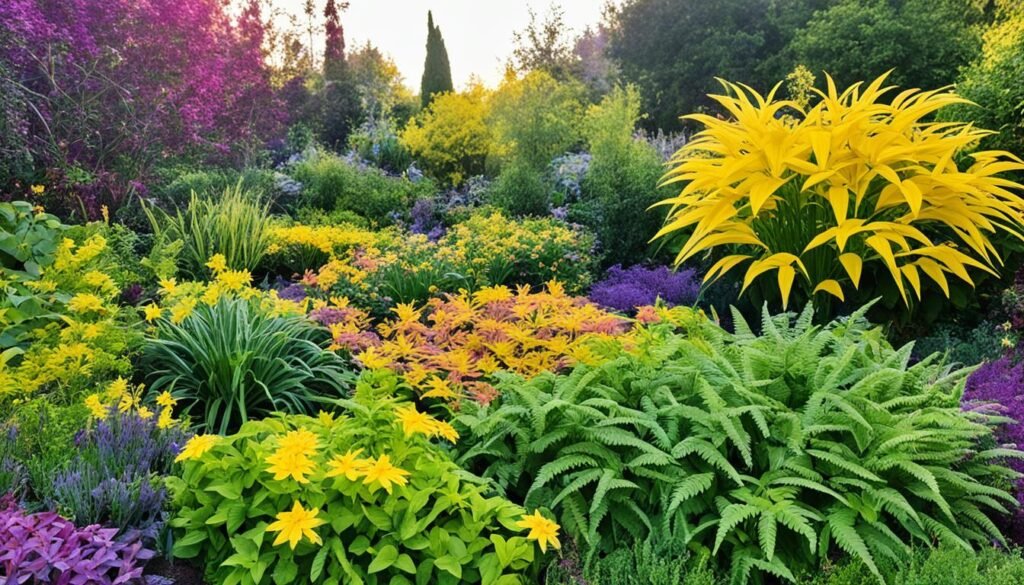
Adding Light to the Landscape
Yellow foliage plants have the incredible ability to add light to the landscape. Their vibrant yellow leaves stand out and create a focal point in any garden or outdoor area. Whether it is a small container garden on a balcony or a sprawling backyard landscape, incorporating yellow foliage plants can infuse the space with a sunny and cheerful atmosphere.
“Yellow foliage plants bring a touch of sunshine to my garden. It’s amazing how they can instantly brighten up the space and create a warm and welcoming ambiance.” – Garden enthusiast
One of the advantages of yellow foliage is its versatility in complementing different design styles and color schemes. It can add a pop of color to a monochromatic or minimalist garden, or it can harmonize with vibrant flowers and foliage in a more eclectic space. The options are endless when it comes to using yellow foliage plants to elevate the overall aesthetic of your garden.
Yellow Foliage Plants for a Radiant Garden
| Plant | Description | Height | Light Requirements |
|---|---|---|---|
| Bush Sunflower | A bushy shrub with sunny yellow flowers and foliage | 3-4 feet | Full sun to partial shade |
| Golden Arborvitae | An evergreen conifer with bright golden foliage | 5-8 feet | Full sun to partial shade |
| Japanese Forest Grass | A cascading grass with radiant yellow leaves | 1-2 feet | Partial shade |
These are just a few examples of the many yellow foliage plants available. Each plant offers its own unique characteristics and can contribute to a garden’s overall beauty and vibrancy.
Adding yellow foliage plants to your garden is like bringing a ray of sunshine into your daily life. Their bright and cheerful nature can instantly elevate the mood and create a captivating landscape that is sure to impress.
Why Do Leaves Turn Yellow and How to Fix the Issue
Leaves turning yellow is a common concern among plant owners. Several factors can contribute to this issue, including under- or overwatering, mineral deficiencies, temperature stress, pests, or natural aging. To fix yellow leaves, it’s important to identify the specific symptoms and address the underlying cause effectively.
Proper watering is crucial for plant health. It’s essential to find the right balance, avoiding both underwatering and overwatering. This can be achieved by regularly checking the moisture level of the soil and adjusting the watering frequency accordingly.
Mineral deficiencies can also cause yellow leaves. By adjusting the nutrient levels in the soil through fertilization, plant owners can provide the necessary elements for healthy growth and prevent yellowing.
Temperature stress can lead to leaf discoloration. Extreme heat or cold can negatively impact plant health, resulting in yellow leaves. Maintaining suitable temperatures by providing shade or insulation can help prevent this problem.
Pests, such as aphids or mites, can infest plants and cause yellowing of leaves. It’s important to regularly inspect plants for any signs of pest activity and take appropriate measures to address the infestation.
Dealing with yellow leaves also requires proper plant care and maintenance. This includes removing any dead or diseased leaves, ensuring good air circulation, and providing ample sunlight for photosynthesis.
Overall, fixing yellow leaves requires a thorough understanding of the underlying causes and a proactive approach to plant care. By implementing these solutions, plant owners can restore the health of their plants and prevent further yellowing.
Conclusion
Plants with colorful foliage, particularly those with yellow and green leaves, can bring vibrancy and visual interest to both indoor and outdoor spaces. They serve as natural artworks that add a lively touch to any environment. Understanding the causes of yellow leaves and implementing proper care techniques is essential for maintaining the health and beauty of these foliage-rich plants.
I have learned that yellow leaves can be a result of various factors such as nutritional deficiencies, diseases, water stress, or pests. By addressing these underlying issues promptly, plant owners can prevent the appearance of yellow leaves and ensure the long-term health of their plants.
To maintain plant health, it is important to focus on providing adequate watering, proper nutrition, and creating a conducive environment. Regularly monitoring the plants for signs of distress and taking immediate action can prevent yellow leaves and preserve the natural beauty of the foliage.
In conclusion, by implementing effective care techniques and taking proactive measures to prevent yellow leaves, plant owners can enjoy the vibrant and captivating beauty of plants with colorful foliage. By nurturing and maintaining their plants, they can create a flourishing and visually appealing environment.
